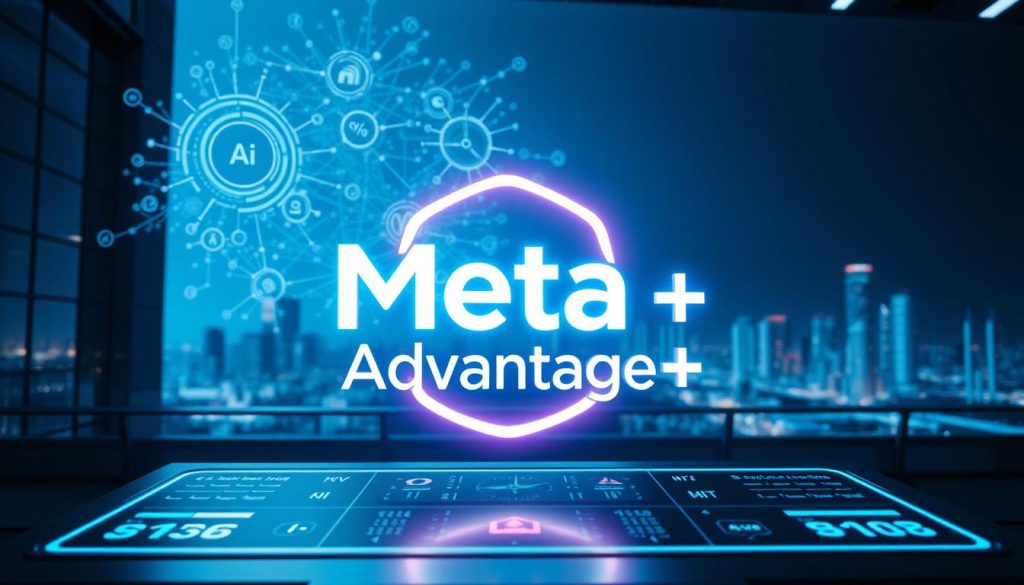One in three ecommerce conversions now traces back to automated campaign flows — a shift that changed how we build and measure ads overnight.
We set the stage for what meta advantage means today. It emerged after iOS 14 as an automation-first response to privacy changes and shifting platform dynamics.
Like Google’s Performance Max, Meta Advantage+ automates bidding, audience selection, creative prioritization, placements, and pacing. This speeds setup, simplifies accounts, and often improves performance for shopping and product sales.
We’ll walk you through who benefits most — U.S. ecommerce brands, app teams, and lean marketers — and where human judgment still matters. Expect practical guidance on goals, data signals, learning periods, and how machine learning tightens results over time.
We want you to gain control over decisions while letting smart automation scale what works.
Key Takeaways
- Advantage+ centralizes prospecting and remarketing to pair product and message at scale.
- Automation speeds launch and often lifts performance for shopping-focused campaigns.
- Marketers must seed clear goals and clean data so learning improves outcomes.
- Watch for accidental opt-ins and reduced transparency; keep guardrails in place.
- Machine learning gets better with conversions; give the system time to learn.
Why Meta Advantage+ matters right now for U.S. advertisers
Right now, automated campaign tools are changing how U.S. advertisers spend and scale. Teams with limited time and lean budgets see value in systems that centralize audience discovery, placements, and budget allocation.
Early reports show ecommerce retailers often get the fastest returns. Longer sales funnels — like B2B or complex lead-gen — usually need stricter measurement and extra controls to protect lead quality.

- Faster launch: Automation cuts setup friction so you focus on creative and strategies.
- Feed the system: Better conversions, values, and event data help performance improve over time.
- Watch defaults: Automatic audience expansion and suggested placements can widen targeting without intent.
- Budgeting tips: Keep tests funded, but shift most budgets to proven winners for consistent results.
| Use case | Time-to-learn | Recommended controls |
|---|---|---|
| Ecommerce | 4–6 weeks | Catalog hygiene, ROAS targets |
| B2B / Lead-gen | 8–12 weeks | Strict conversion tracking, lead scoring |
| Apps | 6–10 weeks | Event-focused signals, SKAN-aware goals |
“Automation speeds ramp, but control comes from clean data and clear goals.”
We recommend small rules and light tools to protect brand standards while letting automation scale. Use the checklist below when deciding whether to rely on this system: product complexity, average order value, sales cycle, and measurement maturity.
What is Meta Advantage+ and how does it work
Since 2022, automated delivery has moved from shopping-only to full-funnel campaigns. The shift began after iOS 14 and the 2022 Advantage Suite, then expanded into broader automation that spans prospecting to remarketing.

From iOS 14 to full‑funnel automation
We trace the path from catalog-focused shopping campaigns to systems that reach users across the journey. One campaign can now find new buyers, retarget past visitors, and push product creative without manual segmentation.
How machine learning powers the system
Machine learning evaluates event fires, catalog engagement, and creative interactions to decide targeting, placements, bids, and creative mixes in near real time.
Similarities and tradeoffs versus Google
This tool mirrors Performance Max: both unify inventory and optimize bidding, audiences, creatives, and budgets. The tradeoffs are familiar — less manual control, harder testing, and less visibility into who sees your ads.
“Automation scales quickly, but clean data and clear goals keep control.”
- Keep event setup and feed hygiene tight.
- Reserve manual levers for exclusions, creative inputs, and measurement.
- Allow learning time; changes can reset performance.
Meta Advantage+
The Advantage+ suite bundles several automated campaign types to simplify how businesses sell on social platforms. We break down what lives inside the suite so you know how each product streamlines delivery and where to add oversight.
Advantage+ sales campaigns (formerly shopping)
Sales campaigns unite prospecting and remarketing in one flow. The system mixes audiences and placements to meet your objective without manual splits.
Catalog ads and dynamic product delivery
Catalog ads pull from a real-time product feed to personalize creative per user and placement. This works across feeds, Reels, Stories, and Audience Network without extra resizing.
App campaigns for installs and in‑app actions
App campaigns optimize for installs or in-app KPIs. They include SKAN support on iOS so measurement stays intact while the system chases high-value events.
Audience, placements, creative, and campaign budget (ACB)
Advantage add-ons extend automation: audience expansion finds incremental reach beyond saved criteria. Placements diversify inventory to lower CPMs. Creative mixes copy and assets per viewer to surface top performers automatically.
ACB reallocates budget in real time to winning ad sets. That boosts efficiency but reduces guaranteed granular spend by placement or set.
- We show how catalog personalization and cross-surface delivery are automation strengths.
- We note where you should add guardrails: brand limits, feed hygiene, and clear KPIs.
- Use these tools together to launch faster and let the system scale what works.
Core Advantage+ products explained in depth
Below, we unpack the suite’s main products and the practical impact each has on campaign performance.
Sales campaigns: unified prospecting and remarketing
Sales campaigns merge upper- and lower-funnel delivery so the system shifts spend toward what drives incremental revenue. The flow prioritizes top creative and balances prospecting with remarketing to scale DTC and retail sales.
Catalog ads: feed quality and placement fit
Catalog ads use dynamic feeds to personalize at the product level. Clean titles, accurate prices, high-quality images, and daily syncs improve catalog personalization and return on ad spend.
App campaigns and SKAN
App campaigns optimize bids, audiences, and placements for installs or ROAS. Advertisers pick objectives and value events. SKAN support restores iOS visibility for high-signal actions.
Creative, placements, audience, and ACB
Creative automates dynamic A/B testing to surface high-performing combinations without heavy manual work. Placements diversify across feeds, Stories, and Reels to lower CPMs.
Automated targeting extends reach beyond saved audiences; use exclusions and seed signals to keep relevance high.
ACB reallocates budget minute-by-minute for efficiency and scale, but it reduces guaranteed spend per ad set and can complicate strict tests.
“Use manual guardrails—frequency caps, exclusion lists, and event priorities—to retain control while automation scales.”
Setting up Advantage+ the right way
A strong launch gives machine learning room to find winners and cut waste. We focus on three setup areas: creatives, measurement, and account structure. Each one speeds learning and prevents common pitfalls.
Creative volume and variety
Start with 20–50 assets and add lightweight variations in headlines, CTAs, and visuals. For Advantage+ shopping, scale to 150 where feasible.
Group creatives by theme, offer, and format so the system tests faster. Frequent but small refreshes reduce fatigue and keep testing efficient.
Data and measurement
Reliable signals matter. Install Pixel and the Conversion API to map high‑value events and pass transaction values. Clean, error‑free product catalogs with custom labels improve delivery and relevance.
Account structure and budgets
Consolidate campaigns to speed learning. Broad targeting and fewer, larger campaigns let the automation find audiences faster.
- Plan a practical budget floor — ~ $30,000 total — to sustain learning windows.
- Keep room for controlled testing: sequence offers, audience seeds, and creatives without resetting learning.
- Use simple management habits: weekly creative refreshes, event audits, and a pre‑launch QA checklist to prevent accidental opt‑ins.
“Clean data, diverse creatives, and consolidated structure are the fastest path to consistent scale.”
Budgets, allocation, and pacing control
Deciding where to place dollars across prospecting, retargeting, and retention shapes whether campaigns scale or sputter.
Advantage systems allow percentage-based budget allocation across funnel stages. Use splits that reflect margin, payback windows, and available inventory.
Allocating spend across prospecting, retargeting, and retention
Start with clear goals and a baseline split. For many retailers, a 60/30/10 prospecting/retargeting/retention model is a useful starting point.
Adjust after a 4–6 week learning window. Increase funding to segments that show stable results.
What to expect from ACB: cannibalization risks and learning windows
ACB moves spend in real time to top performers. That improves short-term efficiency but can cannibalize lower-funded tests.
Protect critical segments with minimum floors, time‑boxed test windows, and frequency caps. Use exclusions and seed audiences to preserve targeting relevance.
- Control: set floors so mission‑critical ad sets keep running.
- Pacing: time-box tests and wait full learning windows before judging.
- Reporting: align spend, reach, and incremental lift so stakeholders trust the path to scale.
“Monitor defaults closely; machine learning improves as conversions accumulate.”
Performance, control, and transparency: the real-world pros and cons
Automation speeds setup, but it also bends how much we can see and control in live campaigns.
What you gain: Faster launches, fewer moving parts, and frequent efficiency gains when product signals are strong. For many ecommerce teams, this means quicker scale and improved performance with less manual setup.
What you risk: Automatic audience expansion and default opt‑ins can flood CRMs with low‑quality leads. Experienced practitioners report bot‑like leads when expansion is left unchecked.
Visibility checklist for real results
- Weekly breakdowns: cost, CPA, and conversion quality.
- Alerts for spikes: sudden lead volume or CPA swings.
- Pause thresholds: suspend suspect segments when quality drops.
Testing discipline and brand guardrails
Rotate fresh creatives to fight fatigue. Enforce frequency caps and time‑boxed tests so learning stays stable.
“Align optimization to revenue, not vanity metrics, so the system learns from value.”
Use exclusions, minimum budgets, and clear briefings to keep control without over‑fragmenting. We recommend regular reports and stakeholder alignment so your team supports the oversight needed for reliable, long‑term performance.
Strategies and use cases across ecommerce, apps, and B2B
We map practical strategies that fit retailers, app teams, and B2B sellers so automation learns from the right signals.
Ecommerce and retail: feed hygiene, catalog strategy, and ROAS levers
Clean, daily‑synced feeds with quality images and custom labels (price tiers, seasonal collections) boost catalog delivery and sales.
Prospecting works best with broad product sets; retargeting uses dynamic ads and value‑based signals to protect margin.
- Keep price accuracy and availability updated daily.
- Use custom labels to surface high-margin items.
- Rotate creatives lightly to sustain performance.
App growth: event selection, optimization goals, and high‑value signals
Pick optimization goals tied to LTV. Choose installs plus in‑app events that matter. The system supports SKAN for iOS and helps raise conversions when signals are accurate.
B2B workarounds: feeding back transaction values and quality controls
Feed back closed‑won values and lead scores via integrations so the campaign can optimize for quality, not just volume.
When volume is low, throttle audience expansion and use strict qualification to protect pipeline value.
| Vertical | Key signal | Primary control |
|---|---|---|
| Ecommerce | Daily feed, product images | Custom labels, ROAS targets |
| Apps | Install + in‑app events | SKAN setup, event‑based goals |
| B2B | Transaction value, lead quality | Integrations, qualification rules |
Advanced oversight: balancing automation with human inputs
Smart automation performs best when paired with deliberate human checks. We build simple systems that protect spend and keep learning healthy. This approach preserves gains while avoiding common blind spots.
Prioritizing human levers: data quality, creatives, and feedback loops
Clean data is the first lever. Pass accurate conversions and values so the system learns true performance.
Maintain a steady creative pipeline. Rotate concepts before fatigue sets in. Feed conversion feedback into your analytics so decisions reflect revenue, not volume.
Layered rules and alerts to protect pacing, tests, and brand guardrails
Layered rules regain control without killing automation. Tools like Bïrch let you enforce minimum spend, pause underperformers, and alert on CPA or frequency spikes.
- Set floors: protect tests so ACB cannot reallocate before results form.
- Alert triggers: CPA spikes, stalled learning, or creative fatigue.
- Brand safety: audience exclusions and placement limits to protect standards.
“Use layered tools to scale wins and stop losses—don’t turn automation off.”
We recommend a simple cadence: daily checks, weekly dives, monthly resets. Document decisions so your team repeats what works and avoids past mistakes as you scale meta advantage campaigns.
Conclusion
Here we summarize how disciplined management turns automated campaign tools into steady sales drivers.
Advantage works best when signals and catalogs are clean. Campaigns scale with clear goals, strong measurement, and creative depth.
Give the system time to learn. Patience plus structured tests unlock compounding performance and more reliable results.
Keep tight oversight: document decisions, set budget floors, and review allocation on a weekly cadence. Protect tests before you scale budgets.
Connect campaign outcomes to broader marketing and product plans. That cross‑functional management helps convert advertising activity into real sales and brand growth.
When you’re ready, partner with us to implement these strategies and make automation a repeatable engine for measurable growth.


